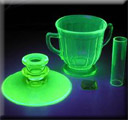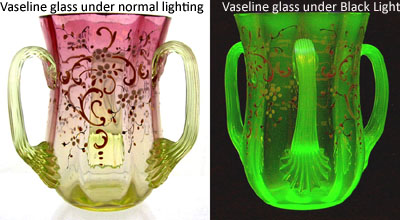 In this article I have explained a few techniques on how to date and test for authenticity of antiques using a black light. Black lights produce Ultra Violet (UV). Many materials fluoresce under ultraviolet lighting producing colors or light that our eyes can see, and making things that might go undetected visible to us. Some clues to age or telltale signs of repair are not easily visible to the naked eye, but will fluoresce under ultraviolet light (black light). While it’s not the end of all answers in antique authentication and dating, it is a good place to start. The following techniques should be used in conjunction with other authenticating tools or research.
In this article I have explained a few techniques on how to date and test for authenticity of antiques using a black light. Black lights produce Ultra Violet (UV). Many materials fluoresce under ultraviolet lighting producing colors or light that our eyes can see, and making things that might go undetected visible to us. Some clues to age or telltale signs of repair are not easily visible to the naked eye, but will fluoresce under ultraviolet light (black light). While it’s not the end of all answers in antique authentication and dating, it is a good place to start. The following techniques should be used in conjunction with other authenticating tools or research.
Contents
1. Authenticating Glassware
Both green Depression glass and Vaseline glass will glow under a black light due to the uranium oxide content in the glass. American colorless pressed glass made before 1930 is said to fluoresce yellow, while reproductions generally do not. It is said that American brilliant cut glass casts a yellow hue under ultraviolet light. American brilliant cut glass is also said to glow pale violet or blue. Given the discrepancies, I suggest following up with further research or consulting a specialist to ensure the authenticity of the cut glass.
Lalique art glass made before 1945 fluoresces yellow, Lalique made after 1945 does not. Genuine old Burmese glassware fluoresces bright yellow green, new reproductions or fakes do not.

Vaseline glass under normal and black light
2. Authenticating Porcelain
Before buying or selling a nice piece of porcelain, always take it into a darkened room with either a handheld or keychain black light to test for repairs. A good repair job might not be visible to the naked eye, but will become obvious under a black light. The glue used in repairs will fluoresce under the black light. Modern paints will glow under the black light as well. This will help you detect any touch-ups, repaints and embellishments that may have been done to the piece. Hard paste porcelain will fluoresce a deep blue or purple color. Soft paste will fluoresce white.
3. Authenticating Fabric and Textiles
Many modern fibers like rayon and polyester, including sewing tread etc made since WW2 will fluoresce under a black light. This helps to date vintage clothing, quilts, rag dolls, stuffed animals, and other items made using cloth. However, additives in modern laundry detergents can cause old fabrics to glow under ultraviolet light if they have been cleaned with these products. I would advice using this with other methods of dating fabrics such as manufacturing techniques, design, provenance and materials used in construction in addition to black light test results.
You can date a ribbon by testing it under the UV light by finding out what type of fiber it has. If a ribbon appears to glow or display fluorescence then that means it has artificial or man made fiber.
4. Authenticating Arts
Modern paint will fluoresce under a black light. This will allow you to easily inspect paintings for touch-ups and repairs. Hairline cracks in oil paintings can also become more visible when examined under ultraviolet light. If you’re a serious art collector, or want to become one, I advise buying a book specific to art inspection to learn more about how ultraviolet lights can be used to test for authenticity and repairs.
5. Authenticating Cast Iron
Many valuable vintage banks, mechanical toys and door stops from the early 1900s were made from cast iron. These genuine cast iron items with original paint are still valuable to passionate collectors. Since most modern paints will fluoresce, you can use your black light to check for reproductions and painted repairs on cast iron pieces. If the paint doesn’t glow, look for other signs of age and wear to make sure the piece is really as old as you think it is. You should also research the markings or signatures that may be on the piece prior to making a purchase.
6. Authenticating Opals
Some minerals display what is called the phenomenon of photo luminescence. This just means that they “glow” when exposed to black light. Opal is an example of a mineral demonstrating fluorescence.
7. Authenticating Ephemera
Old postcards, books, signs, photos and other paper products made before the late 1930s rarely glow under a black light. Chemical bleaches and dyes used in modern papers will fluoresce under a black light. Knowing this helps to detect forged documents and distinguish reproductions in all types of ephemera. I suggest when you are purchasing a rare paper item; have it examined by an expert that specializes in ephemera. This specialist will have knowledge and tools beyond black light testing to aid in the authentication and dating of the item.
The one thing I try to remind all my readers are to do proper research. Take your time while researching, antique items have been around for many years they are not going anywhere fast. If you miss a purchase there is usually another one out there just like it. Please leave your suggestions in the comment area below.
Very helpful information. I’m glad I found it.